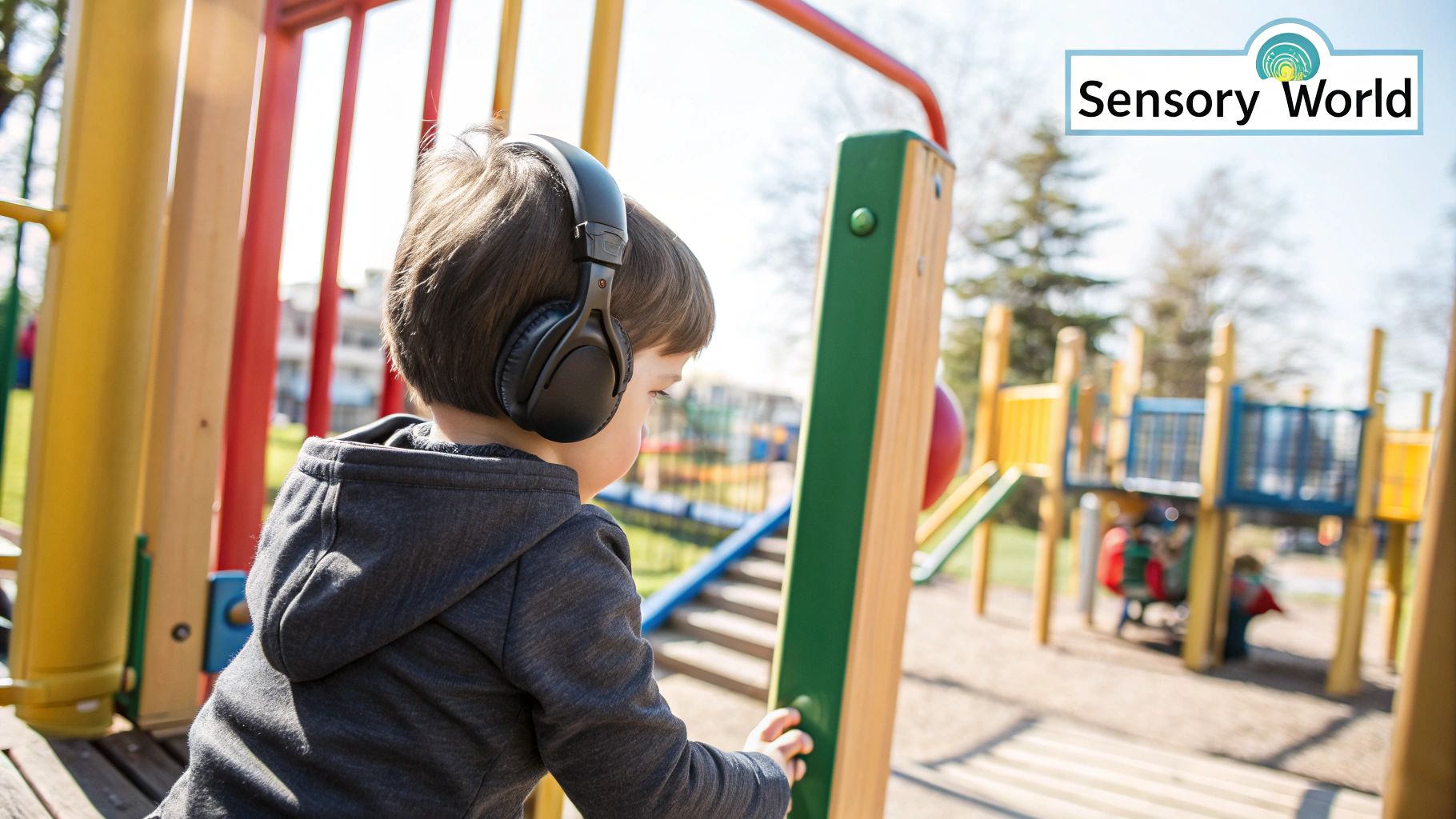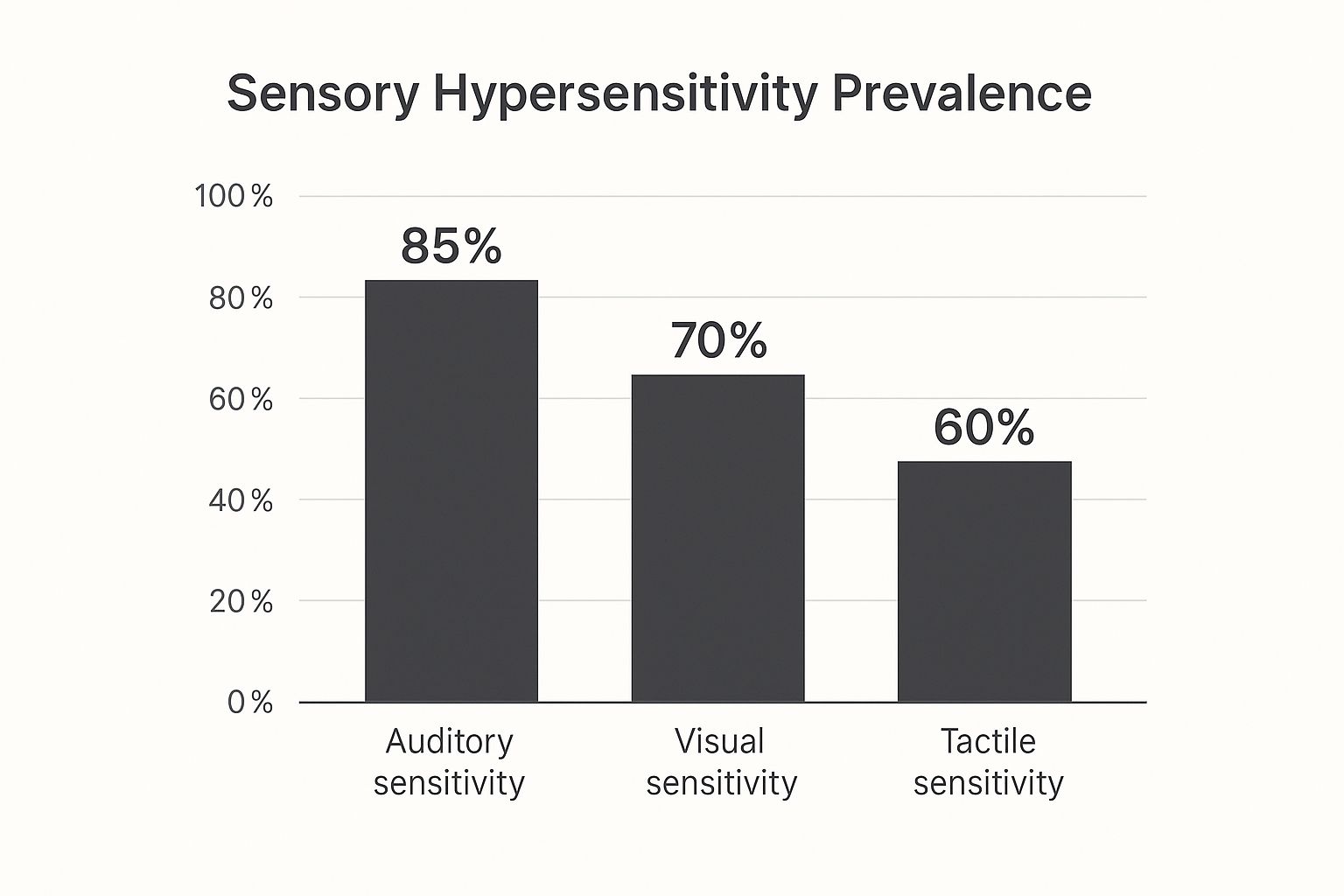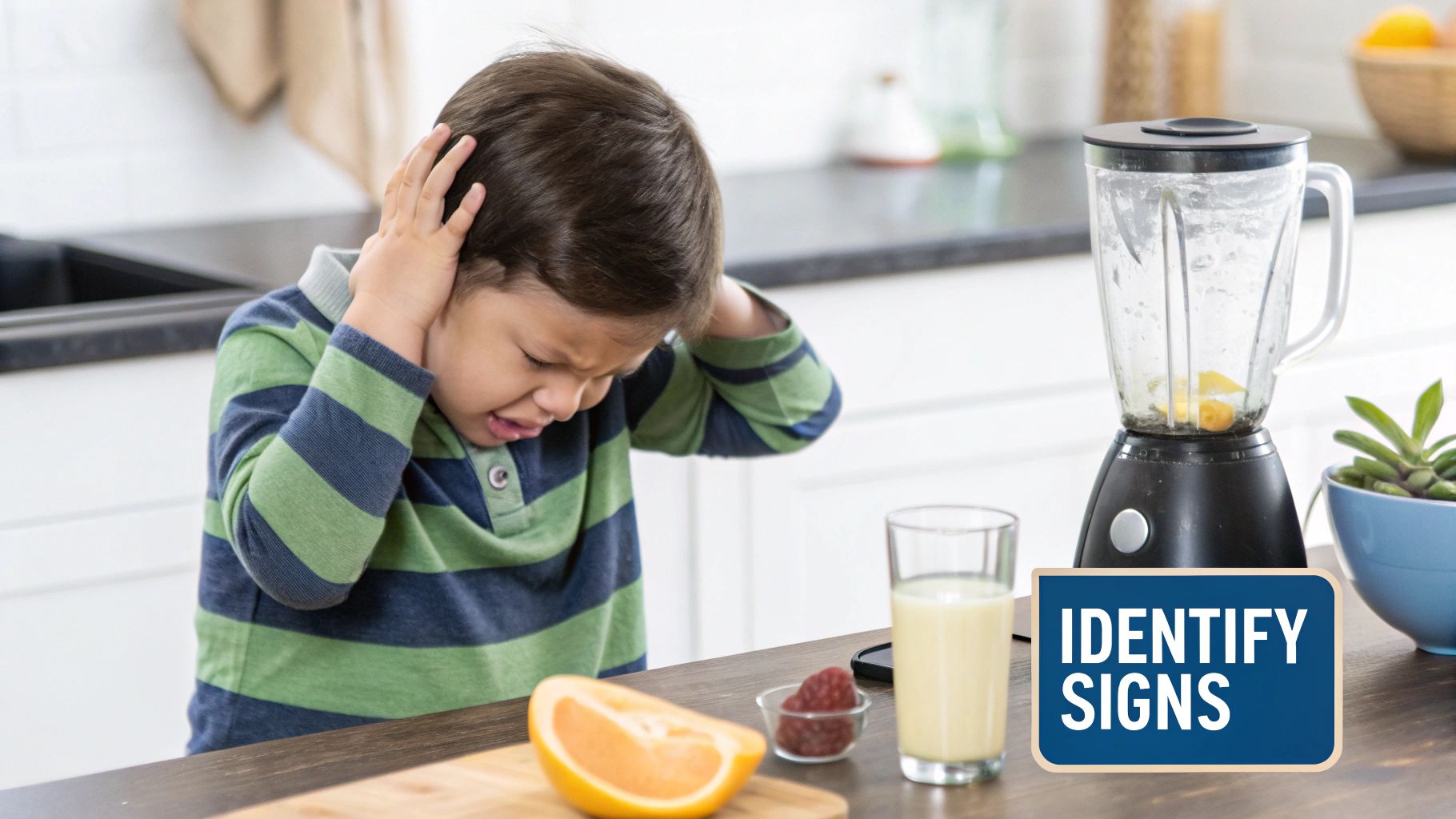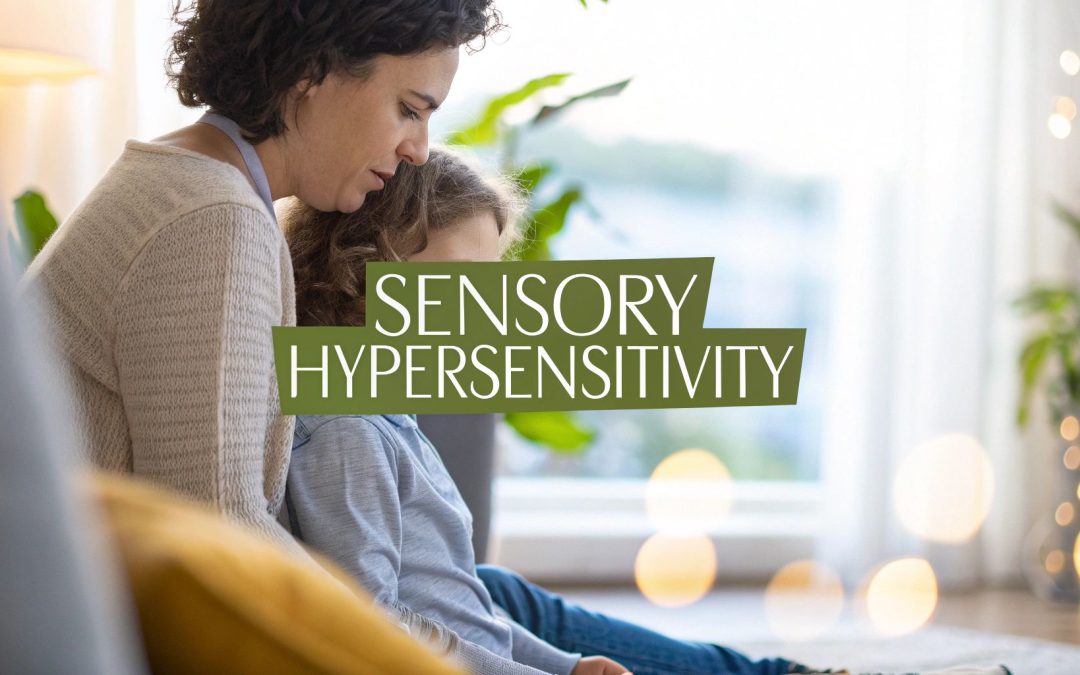When you hear about the connection between autism and hypersensitivity, it’s not just a small piece of the puzzle—it's one of the most foundational aspects of how an autistic person experiences the world around them.
This intense sensory response means everyday things like sights, sounds, and even the feeling of a clothing tag can be amplified to an overwhelming degree. What might be a bustling room to one person can feel like a full-blown assault on the senses for another. This is a fundamental difference in how the brain processes information, not a choice in behavior.
Decoding Your Child's Sensory World

To really step into your child's shoes, picture their sensory system as a super-sensitive microphone that picks up everything without a filter. A neurotypical brain might automatically tune out the low hum of the refrigerator or the barely perceptible flicker of fluorescent lights. An autistic brain often can't—it processes all of that input with equal, and often overwhelming, intensity.
This isn't a flaw; it's simply a different kind of wiring. What might look like a behavioral "overreaction" is almost always a genuine neurological response to feeling completely overloaded. That clothing tag isn’t just a minor annoyance; it can feel like sandpaper scratching their skin. The bright lights of a grocery store aren't just bright; they can feel physically painful.
The Eight Senses in Autism
Most of us learned about the classic five senses in school, but to get the full picture of autism and hypersensitivity, we have to look at all eight sensory systems.
The first five are the ones we all know:
- Sight (Visual): Intense sensitivity to bright lights, busy patterns, or a visually cluttered room.
- Sound (Auditory): Major difficulties with loud, sudden, or multiple overlapping noises.
- Touch (Tactile): A strong aversion to certain textures (like mushy food or stiff jeans), light touches, or getting messy.
- Taste (Gustatory): Extreme reactions to specific food flavors or textures, leading to very selective eating habits.
- Smell (Olfactory): Being overpowered by scents that other people might not even notice.
But it’s the next three senses that are often the missing piece for parents trying to understand their child’s world.
The proprioceptive and vestibular systems are absolutely crucial for understanding how your child experiences their own body and its relationship to the world. When these systems are out of sync, it can impact everything from coordination and balance to their basic feelings of physical safety.
Understanding the Internal Senses
The final three senses are all about our internal world and how we orient ourselves in space.
- Proprioception (Body Awareness): This is our "sixth sense" of knowing where our body parts are without having to look at them. A child with challenges here might seem clumsy, use way too much force when playing, or constantly crash into things.
- Vestibular (Balance and Movement): Governed by the inner ear, this system controls our sense of balance and spatial orientation. A child might be terrified of swings and slides or, on the flip side, constantly seek out spinning and rocking movements to feel regulated.
- Interoception (Internal Body Signals): This is the sense that helps us read our own internal cues—like knowing when we're hungry, thirsty, full, or need to use the bathroom. Challenges here can make self-regulation and potty training incredibly difficult.
It's a lot to take in, but understanding these systems is the first critical step. Research from the National Center for Biotechnology Information has shown that over 90% of autistic people experience some form of sensory hypersensitivity, which profoundly impacts their daily lives.
This heightened sensory input often leads to distress and avoidance as a way to cope. You can dive deeper into the neurology behind these challenges in our guide on what is sensory processing disorder.
Hypersensitivity vs Hyposensitivity in Autism
It's also important to know that sensory processing differences can go in two directions. While some children are hypersensitive (sensory-avoiding), others are hyposensitive (sensory-seeking), and many kids actually experience a mix of both across different senses.
Here's a quick look at how they compare:
| Sensory Profile | Common Behaviors | Everyday Example |
|---|---|---|
| Hypersensitivity (Sensory Avoiding) | Covers ears with loud noises, avoids bright lights, dislikes being touched, is a picky eater due to textures. | A child who becomes distressed in a crowded mall because the lights, sounds, and people feel overwhelming. |
| Hyposensitivity (Sensory Seeking) | Constantly moving, spinning, or crashing into things; seeks out strong flavors; enjoys deep pressure like tight hugs. | A child who can’t sit still and is always looking for things to climb on or jump from to feel regulated. |
Understanding your child's unique sensory profile is key. It helps you shift from seeing "bad behavior" to recognizing a real need that isn't being met, allowing you to provide the right kind of support.
Why Your Child Experiences Sensory Overload
To really wrap your head around sensory overload, let's use an analogy. Think of your child’s brain as having a "gatekeeper" whose only job is to filter all the sensory information coming in—every single sight, sound, and touch. In a neurotypical brain, this gatekeeper is incredibly efficient. It lets the important stuff through and keeps the background noise out.
But for many autistic kids, that gatekeeper isn't working the same way. It's almost like the gate is stuck wide open, letting a constant flood of information rush in all at once. The buzz of the fluorescent lights, the scratchy tag on their shirt, and a conversation happening across the room all hit with the same intensity. This is the heart of the connection between autism and hypersensitivity; it's a difference in neurological processing, not a choice in behavior.
This sensory bombardment can quickly overwhelm the central nervous system. When the brain simply can't process one more thing, it flips the switch on the "fight-or-flight" response. That’s when you see what we recognize as a sensory meltdown.
The Neurological Roots of Hypersensitivity
At its core, sensory hypersensitivity comes down to differences in how the brain is wired. The connections within the brain and nervous system of an autistic person simply process cues from the environment differently. Certain areas of the brain might show a lot more activity in response to stimuli, which helps explain why some sensations feel so incredibly intense to them.
This isn't just a hunch. Studies have shown that genetic factors can account for up to 85% of the overlap between sensory issues and autism. These neurological differences are often present from a very early age, sometimes noticeable even in infants who are later diagnosed.
Understanding this biological foundation is a game-changer for parents. Your child's intense reactions aren't intentional defiance. They are the direct result of a nervous system working in overdrive to manage a world that feels overwhelming.
Understanding this biological basis is the first step toward responding with compassion instead of frustration. It reframes the situation from a "behavioral problem" to a support need, empowering you to find effective strategies that help regulate their nervous system rather than simply manage behavior.
The chart below gives a great visual of how common some of the main types of sensory hypersensitivity are.

As you can see, auditory sensitivity is extremely common. This is exactly why places with loud or unpredictable noises can be so incredibly challenging. When you start to recognize these patterns, you can better anticipate triggers and build a more supportive, sensory-friendly life for your child.
How to Recognize Hypersensitivity Signs

Spotting the signs of autism and hypersensitivity often feels like you're trying to solve a puzzle with missing pieces. What might look like simple defiance or just being "picky" is frequently a child’s only way of telling you they’re in sensory distress.
The real key is learning how to connect their behaviors to their sensory roots before the overwhelm boils over into a full-blown meltdown. These signals aren't always loud and obvious; sometimes, they're quiet patterns of avoidance. Paying close attention to how your child engages with the world around them gives you a clear roadmap to understanding what they truly need.
Auditory and Visual Sensitivity Signs
For many kids, sounds and sights are two of the biggest sources of sensory overload. A child who is hypersensitive in these areas may feel constantly bombarded by a world that seems turned up to the max.
Common clues of auditory hypersensitivity include:
- Covering their ears at sudden or loud noises, like a vacuum cleaner, a blender firing up, or a public restroom hand dryer.
- Becoming visibly distressed in noisy places like a school cafeteria, a friend's birthday party, or even just the grocery store.
- Struggling to focus when there's background noise that most people would easily tune out.
When it comes to visual hypersensitivity, you might notice them:
- Squinting or shutting their eyes under bright fluorescent lights or in direct sunlight.
- Getting overwhelmed in visually "busy" spaces, like a cluttered playroom or a classroom decorated with lots of posters.
- Avoiding eye contact, which can be a way to reduce the overwhelming amount of social and visual information coming in.
Tactile and Olfactory Sensitivity Signs
Touch and smell are deeply personal senses. For an autistic child, hypersensitivity here can turn everyday routines into a major challenge. The feeling of a certain fabric or the hint of a strong scent can be genuinely painful or nauseating.
A child’s refusal to wear a particular shirt isn't about being difficult; it may be that the tag feels like sandpaper or the seam is physically painful against their skin. Understanding this shifts your response from discipline to support.
Look for these tactile sensitivity signs:
- An extreme dislike for specific clothing textures, tags, or seams.
- An aversion to "messy play" with things like finger paint, glue, or sand.
- Reacting negatively to light or unexpected touch, like a friendly pat on the back.
Signs of olfactory (smell) and gustatory (taste) sensitivity often go hand-in-hand and can lead to extremely selective eating habits. A child might refuse food not because of the flavor, but because the texture is completely unbearable. You can explore this topic more by reading about common sensory processing disorder symptoms.
These behaviors are more common than many people realize. According to the Autism and Developmental Disabilities Monitoring (ADDM) Network, the estimated prevalence of ASD among children has climbed from roughly 1 in 150 in the early 2000s to about 1 in 31 in 2022. This jump reflects a much greater awareness of sensory challenges, including auditory, tactile, and visual hypersensitivity. You can read more about the latest autism prevalence data from the CDC to better understand these trends.
Building a Sensory-Friendly Lifestyle for Your Child

Knowing the signs of autism and hypersensitivity is a critical first step, but putting that knowledge into practice is where the real transformation happens in your child's day-to-day life. Creating a sensory-friendly lifestyle isn't about trying to bubble-wrap your child from every possible trigger—that's just not possible. It's really about being proactive and designing environments and routines that lower their sensory stress levels and give them the tools to manage their own needs.
Think of it like turning down the overall sensory "volume" in their world. When the noise is lower, their nervous system finally gets a chance to rest and recharge. By making small, intentional changes, you build a safe harbor that helps stop overwhelm before it even starts, leading to fewer meltdowns and a more comfortable, confident kid.
Creating a Sensory Haven at Home
Home should be the one place on earth where your child feels the safest. By thoughtfully managing the sensory input, you can turn your home into their personal sanctuary.
Even simple changes can be incredibly effective:
- Softer Lighting: Swap out harsh, buzzing fluorescent bulbs for warmer, softer options. Installing dimmer switches or just using lamps gives you real-time control over the light intensity throughout the day.
- Visual Simplicity: Too much to look at can be exhausting. Reduce visual clutter by using closed storage bins and baskets to organize toys and belongings. A clean, organized space is far less demanding on a child’s visual processing system.
- Noise Reduction: Rugs on hardwood floors can do wonders for dampening echoes and softening footsteps. It also helps to be mindful of background noise from TVs or appliances and just turn them off when they aren't being used.
These adjustments help create a predictable, low-stimulation environment where your child’s nervous system doesn't have to be on high alert 24/7.
The Power of a Calm-Down Corner
One of the most powerful tools for self-regulation is a designated "calm-down corner" or sensory space. This isn't a timeout spot for punishment; it's a safe retreat your child can go to whenever they feel they need it.
A calm-down corner gives your child a predictable and accessible space to decompress. It empowers them to recognize their own needs and take positive action to manage their sensory state, building crucial self-advocacy skills.
To make it truly effective, stock the corner with items that offer soothing sensory input.
Some essential elements might include:
- A soft beanbag chair or a pile of large pillows for comfortable seating.
- A weighted blanket or lap pad to provide that calming deep pressure.
- A small selection of quiet fidget toys or sensory tools they love.
- Noise-canceling headphones to block out overwhelming sounds.
- Gentle lighting, like a soothing lava lamp or a fiber optic light.
Building a Portable Sensory Toolkit
Let's face it, the world outside your front door is often unpredictable and overwhelming. That's where a portable "sensory toolkit" comes in. This is simply a backpack or bag filled with essential items that can help your child navigate challenging public spaces like grocery stores, parks, or family gatherings.
Your on-the-go kit could feature:
- Noise-Canceling Headphones: A non-negotiable for blocking out sudden loud noises or the constant hum of a crowded place.
- Sunglasses or a Hat: These are great for managing intense sunlight or the harsh fluorescent lighting you find in most public buildings.
- Fidget Toys: Small, quiet fidgets can provide a discreet outlet for anxious energy and help them focus when things get chaotic.
- Chewable Jewelry: If your child uses oral input to self-soothe, a chew necklace is a safe and effective tool to have on hand.
- A Familiar Comfort Item: A favorite small toy or a piece of a soft blanket can provide a powerful sense of security in a new or stressful environment.
By preparing ahead, you're not just managing the moment—you're equipping your child to face the world with greater confidence, knowing they have what they need to cope with sensory challenges.
Supporting Your Child’s Nervous System
When sensory inputs stack up one after another, a child’s nervous system can feel like it’s under siege. Creating a calm, sensory-friendly home environment is a great start. But for many families, adding specialized pediatric chiropractic care brings another layer of support.
Imagine your child’s nervous system as a finely tuned violin string that’s just a little too tight. Gentle, precise chiropractic adjustments work like the tuning peg, easing tension and cutting through that background “static” so the brain and body can communicate more clearly.
Shifting From Fight-Or-Flight To Rest-And-Digest
When a child’s senses are overloaded—bright lights, loud noises, unexpected touch—the nervous system often locks into fight-or-flight mode. In this state of heightened alarm, even simple tasks can feel like navigating a minefield.
Neurologically focused chiropractic care aims to guide the body back to rest-and-digest, the parasympathetic state where healing and growth happen. This shift isn’t just theoretical; it lays the groundwork for a calmer, more resilient response to everyday stimuli.
By helping the nervous system find a more balanced state, we can improve the body’s resilience to sensory stressors. This can lead to tangible benefits like better sleep, improved emotional regulation, and a greater tolerance for sensory stimuli that were once unbearable.
Recent global health data highlights how sensory hypersensitivity is a core contributor to disability-adjusted life years in autism, underscoring the need for care strategies that address these fundamental challenges. You can discover more about the global health impact of sensory dysfunction in recent studies.
Tangible Benefits Of A Calmer Nervous System
When the nervous system isn’t locked in overdrive, real-world improvements start to emerge. Families often report:
- Better Sleep Patterns: Falling asleep and staying asleep become less of a nightly struggle.
- Improved Emotional Regulation: Fewer meltdowns and a smoother ride through daily ups and downs.
- Greater Comfort In Social Settings: Crowded cafeterias or busy playgrounds feel less intimidating.
Ultimately, supporting your child’s nervous system helps them process the world more effectively—from a gentle touch to a crowded room. You can learn more about the link between autism and nervous system regulation in our detailed guide. This foundational support empowers children to face each day with greater ease and confidence.
Your Questions on Hypersensitivity Answered
Stepping into the world of autism and hypersensitivity naturally brings a lot of questions to the surface. As you get better at recognizing the signs and start building a more sensory-friendly life for your child, you'll likely wonder about the fine details—diagnoses, what the future looks like, and how to react when things get overwhelming.
This section is all about giving you clear, straightforward answers to the questions we hear most often from parents. Our goal is to provide the practical clarity and reassurance you need to support your child with confidence.
Is Sensory Hypersensitivity the Same as Sensory Processing Disorder?
This is a fantastic question because these terms get used interchangeably all the time. While they are definitely related, they aren't exactly the same thing.
Here’s a good way to think about it: Sensory Processing Disorder (SPD) is the big-picture condition where the brain has a tough time receiving and responding to information coming in from the senses. Imagine an air traffic control system that’s struggling to organize all the incoming and outgoing signals—that’s SPD.
Hypersensitivity is just one specific challenge that falls under that big SPD umbrella. It’s the "over-responsive" piece, where the nervous system gets totally swamped by stimuli. But SPD can also include hyposensitivity (being under-responsive) or even a mix of both. And while hypersensitivity is a key part of an autism diagnosis, not everyone with SPD is autistic.
Will My Child Outgrow Their Sensory Sensitivities?
Sensory sensitivities are often a lifelong part of being autistic, but the way your child manages them can change in a huge way over time. The real goal isn't to make the sensitivity just disappear, but to lessen the distress and disruption it causes.
With the right supportive strategies, therapies, and a real understanding of their unique needs, children learn powerful ways to cope. They get much better at spotting their triggers, telling you what they need, and using tools to regulate themselves.
The objective shifts from "curing" the sensitivity to building resilience. Over time, your child can learn to navigate their environment so effectively that their sensitivities no longer hold them back from participating in a full and happy life.
This journey is all about empowering them to advocate for themselves and create a world that actually works for them. It turns what could be a challenge into a well-managed part of their unique identity.
How Can I Tell the Difference Between a Sensory Meltdown and a Tantrum?
Learning to spot the difference between a meltdown and a tantrum is one of the most important skills a parent can develop because they require completely different responses. The key difference really comes down to control and motivation.
A tantrum is usually behavioral and has a goal. A child wants something—a toy, a snack, to avoid leaving the playground—and is using their behavior to try and get it. The tantrum typically stops once they get what they want or they figure out it isn't going to work.
A sensory meltdown, on the other hand, is an involuntary neurological reaction. It’s what happens when the brain and nervous system are so overloaded with sensory input they just can’t cope anymore. The child has lost control.
Here’s how to tell them apart:
- Tantrum: The child is in control of their actions and is usually watching for your reaction.
- Meltdown: The child has lost control and often isn't even aware of their surroundings or your reaction.
- Tantrum: It’s driven by a want or a desire.
- Meltdown: It's triggered by sensory or emotional overwhelm.
Recognizing that it's a meltdown allows you to respond with compassion and support—like dimming the lights or cutting out noise—instead of with discipline.
At First Steps Chiropractic, we are dedicated to helping your child's nervous system find balance and resilience. By focusing on the root cause of sensory dysregulation, we can support your family's journey toward greater comfort and well-being. Learn how neurologically focused chiropractic care can make a difference by scheduling a consultation.

